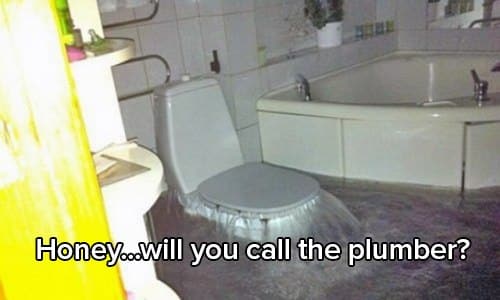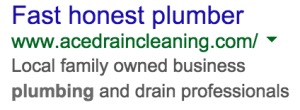3 Pay-Per-Click Tricks Every Plumbing/HVAC Company Should Use
by Colby Zimmerman • October 12, 2015
Having helped plumbing/HVAC companies across the country with their pay-per-click (PPC) campaigns, it seems like most companies make a few important mistakes that cost them tens of thousands of dollars in wasted ad spend.
Fortunately, correcting those mistakes not only makes your PPC campaigns more effective and profitable—it also sets your company up to dominate your market.
Believe me, I speak from experience.
Unfortunately, most plumbing/HVAC companies don’t have the time or resources to figure out or fix these problems. After all, their job is to take care of other people’s problems, not worry about the minutia of PPC management.

So, to make life easier for you, here are 3 of the biggest PPC mistakes plumbing/HVAC companies make and—more importantly—how to fix them.
Mistake #1 – Poor Keyword Strategy
To start with, you need to use the right keyword strategy. This might seem obvious, but most plumbing/HVAC companies never get this part right.
For example, many plumbing/HVAC companies use the same sets of ads for all of their keywords. Now, if someone is searching for “plumbing repair,” an ad like this probably isn’t terrible:

The problem arises when that same ad gets used for someone searching for “leak detection.” In the first case, the ad still required the searcher to conclude that a “fast honest plumber” was a good match for their plumbing repair needs. That’s not too much of a stretch, so the ad might work.
But, if they are searching for “leak detection,” an ad for a “fast honest plumber” leaves the searcher with a lot of questions. He’s honest, but does he do leak detection? The ad says “plumbing and drain professionals,” but—again—I’m not sure if they do leak detection.
Compelling ad copy ties the intent of the searcher (their keywords) to the ad (what they are searching for). So, the more closely aligned the ad copy is with the search terms that triggered it, the more likely a searcher is to think, “Yes, that’s what I am looking for!” and click on your ad.
The Fix
The key to solving this problem is identifying which search terms are the most effective for your business. Once you know what drives the most leads for your business, you can then use that information to develop single keyword ad groups.
Also referred to as SKAGs, single keyword ad groups combine the exact, phrase and/or broad match keywords for a particular search term with an ad targeted to that phrase.
For example, here is some ad copy that targets the keyword “leak detection” much more effectively than the former example:
 Anyone searching for “leak detection” instantly knows that they found exactly what they were looking for. Plus, if they call today, they get 25% off!
Anyone searching for “leak detection” instantly knows that they found exactly what they were looking for. Plus, if they call today, they get 25% off!
This ad works well because it ties the ad copy to the keywords. The ad only triggers if someone is searching for something relevant to the ad. So, when they see the ad, they are much more likely to click on it!
For my clients, adopting a SKAGs-based keyword strategy has quickly doubled their click-through-rate, so it is a great way to start driving more (and the right sort of) traffic to your website.
Mistake #2 – Sending PPC Traffic to Your Home Page
PPC clicks have to go somewhere, so most plumbing/HVAC companies send PPC traffic to their company website. After all, they’re looking for a plumbing company and that’s your plumbing company’s website, right?
The problem is, you offer a lot of services and the person who just clicked on your “water leak” ad doesn’t need to know that you can install an air conditioner for them. However, if they’re looking for someone to install an air conditioner, they don’t care about your leak repair services!
So, your home page has to please everybody, which means it needs to list all your services. That’s not really a problem until you start driving paid traffic to your site.
Paid traffic clicks on your ad expecting to have a specific need addressed and—if the page they land on after clicking your ad doesn’t obviously match the service they are interested in—they’ll leave!
That means you have to list everything on your home page so that those expensive PPC clicks can find what they are looking for…but, listing everything confuses people and makes them less likely to use your business. It’s a lose-lose situation!
The Fix
The solution to this problem is actually very simple. It takes extra time and effort, but trust me, the results are worth it.
Rather than pointing your traffic to your home page, you need to point it to a “landing page” dedicated to meeting the needs of a specific type of traffic. For example, if you click on an add that advertising “Leak Detection” and arrive on a page that talks about “Leak Detection,” you have a much better chance of feeling like you’re in the right place.
Can you see why landing pages are so important? In my experience, sending PPC traffic to a dedicated landing page often doubles (sometimes triples) the effectiveness of a PPC campaign.
And that’s just the beginning. Once you’ve got a good set of landing pages in place, you can then begin to optimize those pages to produce the maximum number of leads possible…but we’ll leave that blog post for later.
Mistake #3 – No Call Tracking
If you’re running a successful plumbing/HVAC business, you’re getting a lot of calls. Calls are the lifeblood of your business, wouldn’t you love to know how someone got your number?
Unfortunately, people rarely call in and say, “Hey, I saw your billboard a couple of months ago and—when my toilet exploded—I thought of your company.”
This makes it very difficult to determine the value of different marketing activities. Was the billboard worth the money? Who knows?
This is particularly important when it comes to PPC advertising. PPC is a great way to get plumbing/HVAC leads, so it’s no surprise that the cost-per-click for plumbing/HVAC ads has increased dramatically. To get the most out of your budget, you need to know which clicks are producing quality leads.
However, since most of your PPC leads are phone calls, how do you know which ads produced which calls?
The Fix
There are a variety of different call tracking programs you can implement with relative ease. Again, just like setting up dedicated landing pages, the results are well worth the time and effort it takes to set up call tracking.
Google actually has a free call forwarding feature that you can use to track which ads resulted in which phone calls. Alternatively, there are a lot of other options like Call Tracking Metrics, Five9 that provide additional options (like call recording or CRM integration) your company may find useful.

Once it’s in place, call tracking will transform the way you look at your PPC campaigns. You’ll know exactly how your campaigns are performing and how specific changes in ad copy, landing pages, bidding or anything else affect your campaigns effectiveness.
For my clients, call tracking has helped them dramatically improve their lead volume and cost-per-lead in sustainable ways. With the ever increasing competition in PPC marketing, who wouldn’t want that?
Conclusion
For my clients, fixing these 3 common pitfalls has made a night-and-day difference to the effectiveness of their plumbing/HVAC pay-per-click campaigns. Doubled click-through-rate and doubled conversion rate have meant 4x the number of leads for effectively the same price!
As I said before, setting your campaigns up for success will take some extra effort, but the ability to rise above the competition and make more money for less is definitely worth the investment.
If you’d like me to take a look at your campaigns and see what these tricks and others can do for your business, let me know! I’d be happy to give you an honest appraisal of how your campaigns are running.
You’ve heard what I’ve got to say, now it’s your turn. Where have you seen plumbing/HVAC campaigns wasting money and leads?





